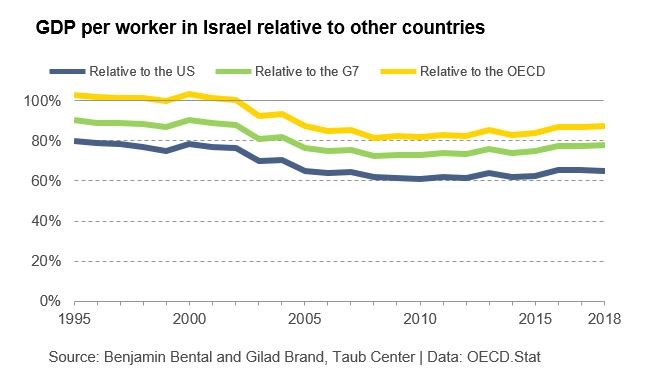In recent years, the Israeli economy has displayed relatively stable growth and a tight labor market. However, the country’s per-capita GDP is growing relatively slowly and the fiscal system is subject to increasing pressure. At the same time, there are signs that domestic competition is intensifying, and that Israeli price levels are approaching those in other developed countries.
Growth in Israel’s economy
- Israel’s GDP per person employed has, for the last several years, stood at 65% of the comparable US figure, and at 85% of the OECD average.
- Israel’s poor labor productivity is also related to its low level of public capital (including transportation, education, and healthcare infrastructure) which has steadily eroded from a ratio almost equal to that of the OECD countries half a century ago to a ratio half that of the OECD average today.
- Based on the assessment methods commonly employed in economic research, had Israel’s public-capital-to GDP ratio been similar to that of the OECD countries, its GDP per person employed (and, as a result, its wage levels) would have been about 16 percentage points higher, reaching the OECD average.
- Israel’s fiscal policy in recent years has caused the country to surpass its legally-mandated deficit and spending limits. Compared to a deficit of 2.9% of GDP in 2018, according to reports by the Ministry of Finance, the deficit is expected to reach 4% of GDP in 2019, and 4.5% by 2022.

Household income and inequality
Recent years have witnessed a steep rise in the income of households in the middle and lower portions of the income distribution. At the same time, there is growing evidence that Israeli prices are slowly converging to those in other developed countries.
- During the period 2012-2017, the net income of households in the middle and lowest quintiles rose at an average annual rate of 4%, versus just 2.6% for the highest quintile. This indicates that growth is “trickling down” to the weaker socioeconomic strata, in contrast to other developed countries.
- The past decade saw a steady decline in income inequality in Israel as a result of rapid increases in labor income in the lower income deciles, owing to a rise in wages and an increase in employment rates. Yet, income inequality is still high relative to other developed countries.
- Since 2014, Israeli consumer prices have fallen by about 5% compared with the G7 nations. Still, the prices in Israel are still about 12% higher than what would be expected of an economy with Israel’s per-capita income level.
- Up until 2015, foreign price increases raised domestic prices within a few months’ time, while price reductions lowered Israeli prices to only a limited degree, and with a substantial delay. However, since 2015-2016, this asymmetry seems to have disappeared and domestic prices appear to adjust relatively quickly to foreign prices whether they rise or fall.


